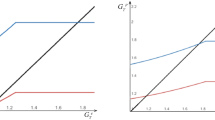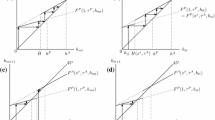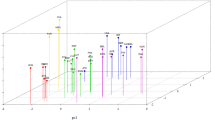Abstract
This paper models voters’ preferences over central versus local education policies when there are private alternatives. Education is financed by income taxes and individuals are mobile between communities. Public education levels are chosen by majority vote. Contrary to conventional wisdom, centralisation may benefit the rich and poor, while the middle class prefer decentralised education. The model is also extended to include peer effects. Peer effects increase the support for central school finance, even in the community with good public schools.
Similar content being viewed by others
References
Alesina, A., & Spolaore, E. (1997). On the number and size of nations. Quarterly Journal of Economics, 112, 1027–1056.
Bearse, P., Glomm, G., & Ravikumar, B. (2001). Education finance in a dynamic Tiebout economy. Mimeo.
Bolton, P., & Roland, G. (1997). The breakup of nations: a political economy analysis. Quarterly Journal of Economics, 112, 1057–1090.
Borck, R. (1998). Centralization of public good supply with majority voting. FinanzArchiv, 55, 21–40.
Cohen-Zada, D., & Justman, M. (2003). The political economy of school choice: linking theory and evidence. Journal of Urban Economics, 54(2), 277–308.
de Bartolome, C. A. M. (1990). Equilibrium and inefficiency in a community model with peer group effects. Journal of Political Economy, 98, 110–133.
Epple, D., & Romano, R. E. (1996). Ends against the middle: determining public service provision when there are private alternatives. Journal of Public Economics, 62, 297–325.
Epple, D., & Romano, R. E. (1998). Competition between private and public schools, vouchers, and peer-group effects. American Economic Review, 88, 33–62.
Fernandez, R., & Rogerson, R. (1999). Education finance reform and investment in human capital: lessons from California. Journal of Public Economics, 74, 327–350.
Fernandez, R., & Rogerson, R. (2003). Equity and resources: an analysis of education finance systems. Journal of Political Economy, 111(4), 858–897.
Franc, C., & Abadie, L. (2004). Opting out of public insurance: is it socially desirable?. Geneva Papers on Risk and Insurance: Theory, 29, 115–136.
Gans, J. S., & Smart, M. (1996). Majority voting with single-crossing preferences. Journal of Public Economics, 59, 219–237.
Hansen, N. A., & Kessler, A. S. (2001). (Non)-existence of equilibria in multicommunity models. Journal of Urban Economics, 50, 418–435.
Jouvet, P.-A., Michel, P., & Pestieau, P. (2004). Public and private environmental spending: a political economy approach. CORE discussion paper 2004/68.
Jürges, H., Schneider, K., & Büchel, F. (2005). The effect of central exit examinations on student achievement: quasi-experimental evidence from TIMSS Germany. Journal of the European Economic Association, 3, 1134–1155.
Nechyba, T. (2003a). School finance, spatial income segregation and the nature of communities. Journal of Urban Economics, 54, 61–88.
Nechyba, T. J. (1999). School finance induced migration and stratification patterns: the impact of private school vouchers. Journal of Public Economic Theory, 1, 5–50.
Nechyba, T. J. (2003b). Centralization, fiscal federalism, and private school attendance. International Economic Review, 44(1), 179–204.
OECD (2004). Education at a glance: OECD indicators. Paris: OECD.
Solon, G. (1992). Intergenerational income mobility in the United States. American Economic Review, 82(3), 393–408.
Stiglitz, J. E. (1974). The demand for education in public and private school systems. Journal of Public Economics, 3, 349–385.
Zimmerman, D. J. (1992). Regression toward mediocrity in economic stature. American Economic Review, 82(3), 409–429.
Author information
Authors and Affiliations
Corresponding author
Rights and permissions
About this article
Cite this article
Borck, R. Central versus local education finance: a political economy approach. Int Tax Public Finance 15, 338–352 (2008). https://doi.org/10.1007/s10797-007-9029-9
Published:
Issue Date:
DOI: https://doi.org/10.1007/s10797-007-9029-9




